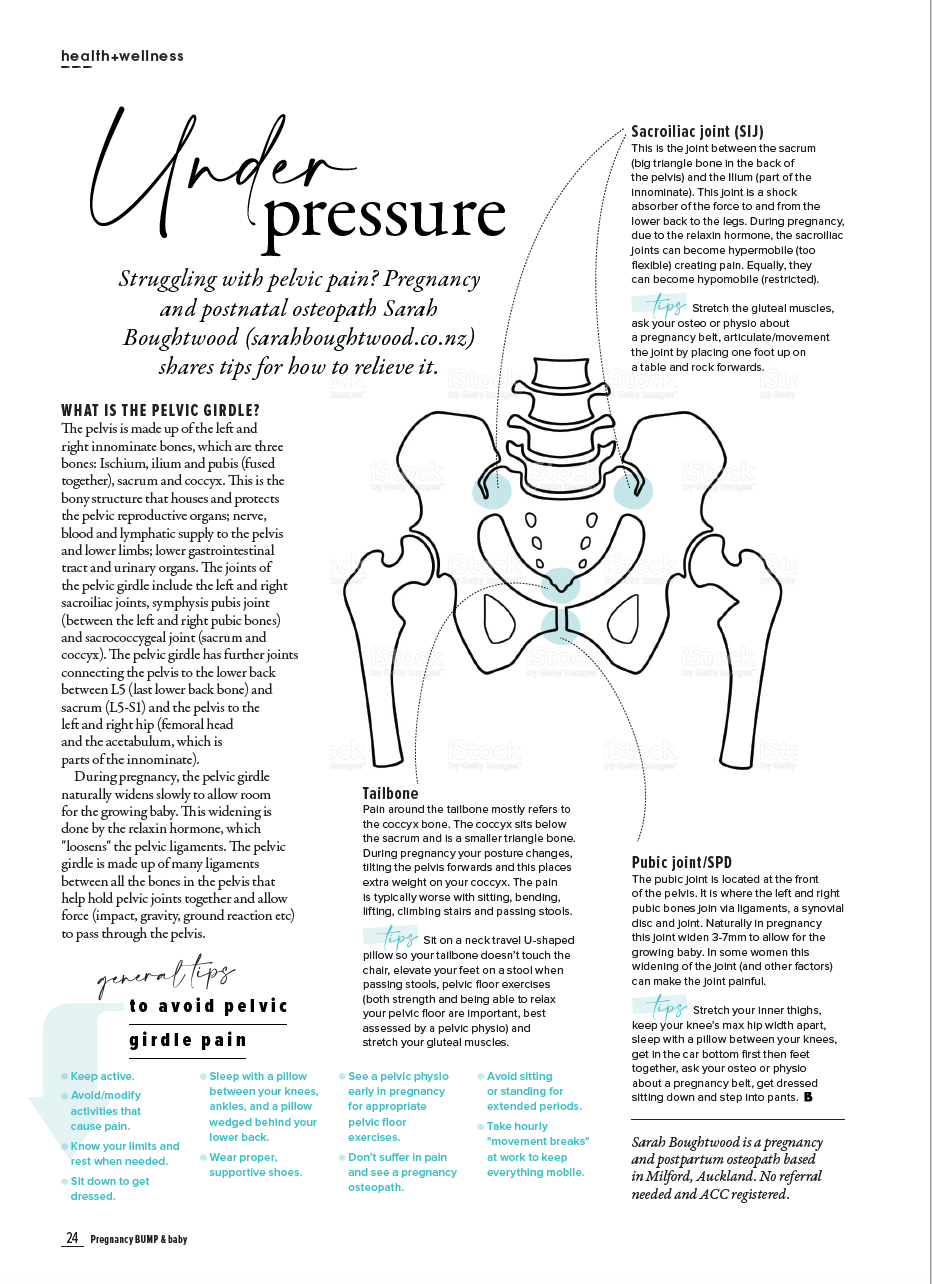Pregnancy, Bump & Baby – Under pressure, pelvic girdle pain
What is the pelvic girdle?
The pelvis is made up of the left and right innominate bones which are 3 bones (Ischium, Ilium & Pubis) fused together, sacrum and coccyx. This is the bony structure that houses & protects the pelvic reproductive organs, nerve + blood + lymphatic supply to the pelvis & lower limbs, lower gastrointestinal tract and urinary organs. The joints of the pelvic girdle include the left and right sacroiliac joints, symphysis pubis joint (between the left and right pubic bones) and sacrococcygeal joint (sacrum & coccyx). The pelvic girdle has further joints connecting the pelvis to the lower back between L5 (last lower back bone) and sacrum (L5-S1) and the pelvis to the left and right hip (Femoral head and the acetabulum, which is parts of the innominate).
During pregnancy the pelvic girdle naturally widens slowly to allow room for the growing baby. This widening is done by the Relaxin hormone, which ‘loosens’ the pelvic ligaments. The pelvic girdle is made up of many ligaments between all the bones in the pelvis that help hold pelvic joints together and allow force (impact, gravity, ground reaction etc) to pass through the pelvis.
Locations of pain with tips
The most areas of pelvic girdle pain are:
Sacroiliac joint (SIJ)
This is the joint between the sacrum (big triangle bone in the back of the pelvis) and the Ilium (part of the innominate). This joint is a shock absorber of the force to and from the lower back (lumbar spine) to the lower extremities (legs). During pregnancy, due to the Relaxin hormone and the sacroiliac joints can become hypermobile (too flexible) creating pain. Equally they can become hypomobile (restricted).
Tips- Stretch the gluteal muscles, ask your osteo or physio about a pregnancy belt, articulate/movement the joint by placing one foot up on a table and rock forwards.
Tailbone
Pain around the tailbone mostly refers to the coccyx bone. The coccyx sits below the sacrum and is a smaller triangle bone. During pregnancy your posture changes, tilting the pelvis forwards and this places extra weight on your coccyx. The pain is typically worse with sitting, bending, lifting, climbing stairs and passing stools.
Tips- Sit on a neck travel ‘U’ shaped pillow so your tailbone doesn’t touch the chair, elevate your feet on a stool when passing stools, pelvic floor exercises(both strength and being able to relax your pelvic floor are important, best assessed by a Pelvic Physio) and stretch your gluteal muscles.
Pubic joint/SPD
The pubic joint is located at the front of the pelvis. It is where the left and right pubic bones join via ligaments, a synovial disc and joint. Naturally in pregnancy this joint widen 3-7mm to allow for the growing baby. In some women this widening of the joint (and other factors) can make the joint painful.
Tips- Stretch your inner thighs (adductors), keep your knee’s max hip width apart, sleep with a pillow between your knee’s, get in the car bottom first then feet together, ask your osteo or physio about a pregnancy belt and get dressed sitting down and step into pants.
General tips to avoid pelvic girdle pain
- Keep active
- Avoid/modify activities that cause pain
- Know your limits and rest when needed
- Sit down to get dressed
- Keep your knee’s max hip width apart
- Sleep with a pillow between your knee’s, ankles and a pillow wedged behind your lower back
- Wear proper, supportive shoes
- See a pelvic physio early in pregnancy for appropriate pelvic floor exercises
- Don’t suffer in pain and see a pregnancy Osteopath
- Avoid sitting or standing for extended periods
- Hourly ‘movement breaks’ at work to keep everything mobile
Sarah Boughtwood is a pregnancy and postpartum osteopath based in Milford, Auckland. No referral needed and ACC registered.
Sarah Boughtwood
Pregnancy & Postpartum Osteopath
0211397270
@sarahboughtwoodosteopath
www.sarahboughtwoodosteopath.co.nz

